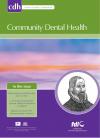Community Dental Health

- Cover Date:
- September 2007
- Print ISSN:
- 0265 539X
- Vol:
- 24
- Issue:
- 3
Assessment of orthodontic treatment needs in Brazilian schoolchildren according to the Dental Aesthetic Index (DAI).
Objective: To assess the distribution, prevalence and severity of malocclusion and orthodontic treatment needs in schoolchildren from the northeast of Brazil aged between 13 and 15 years. Research design: Cross-sectional study. Participants: A sample of 600 adolescents (264 males and 336 females) randomly selected and representative of schoolchildren living in Recife (Brazil) was obtained from 12 public schools. Method: The need for orthodontic treatment was measured using the Dental Aesthetic Index (DAI). Results: Most of the subjects (77%) were deemed to require orthodontic treatment. Only about 5.8% had a handicapping malocclusion that needed mandatory treatment. A severe malocclusion for which treatment was highly desirable was recorded in 47.5% of the adolescents and 23.7% had a definite malocclusion for which treatment was elective. Three main occlusal features were responsible for allocating subjects into the group of “orthodontic treatment requiredâ€: crowding (47.3%), tooth loss (22.3%) and maxillary overjet of more than 3mm (21.8%). There were no significant differences (p>0.05) in mean DAI scores between males and females. Conclusions: 77% of adolescents from northeast Brazil were in need of orthodontic treatment for dental health reasons. The distribution of DAI scores among Brazilian adolescents is different from that reported in other populations. This study provides baseline data on the need and demand for orthodontic treatment among Brazilian students.
Key words: Dental Aesthetic Index (DAI), malocclusion, treatment need
- Article Price
- £15.00
- Institution Article Price
- £
- Page Start
- 145
- Page End
- 148
- Authors
- C.R. Marques, G.B.L Couto, S. Orestes Cardoso
Articles from this issue
- Title
- Pg. Start
- Pg. End
- The prescription and outcomes of fissure sealants applied to a group of high caries risk children by general dental practitioners working in the North West of England
- 135
- 139
- Assessment of orthodontic treatment needs in Brazilian schoolchildren according to the Dental Aesthetic Index (DAI).
- 145
- 148
- Dental caries in 5-year-old children attending multi-ethnic schools in Greater Glasgow – the impact of ethnic background and levels of deprivation
- 161
- 165
- Cross-cultural adaptation of the Oral Health Impact Profile (OHIP) for the Malaysian adult population.
- 166
- 175
- Reduction of caries in rural school-children exposed to fluoride through a Milk-Fluoridation Programme in Araucania, Chile
- 186
- 191
- Getting through Dental Fear with CBT: A young person’s guide. Helen Chapman and Nick Kirby-Turner. ISBN 1-904127-07-X. Blue Stallion Publications, Oxon. £4.95
- 192
- 192
